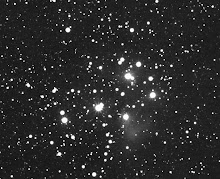Hoping to find the path to Terran normalcy now, after six thousand years of warlike struggle and nuclear conflict finally attained the Moon, the immense antiquity of that goal begins to make appear sometimes as if people want to devolve to early mammals, or wilderness primitives at best. The danger is that we will not find the way to worldwide peace until civilization devolves too far, and either much time must pass before the serious errors are corrected, or some conflict like thermonuclear or biological war breaks out. After all, the world cannot spend the entire next million years in war. Recognizing that a solution is in principle possible makes war even more of a heartbreak than it ever seemed to be before it was known there are no space aliens on the Moon that require such weapons.
New discoveries of early human artifacts date back to 30,000 years and more. They include the use of adhesives as glue, beads, arrows, poisons, rocks for anvils and rocks. ( http://www.bbc.co.uk/news/science-environment-15565654 )
Some kinds of stone tools-hammer-stones, stone cores, and sharp stone flakes-date back over 2 million years. ( https://humanorigins.si.edu/evidence/behavior/tools )
People love to use tools to build their houses and furnish them. That's one of the reasons the unashamedly more primitive Russians simply let the people devolve themselves back to what they wanted. The results look like nothing so much as a native American neighborhood where cars are left to rust because they are in the natural order if they rust away where they stopped, and where houses often have ramshackle home made roofs and walls. Urban codes at the present time are based on the assumption that only professional, trained builders are fit to build homes, and the homes look like it. They are grand, to be sure. But what keeps a population peaceful is building their own homes.
New discoveries of early human artifacts date back to 30,000 years and more. They include the use of adhesives as glue, beads, arrows, poisons, rocks for anvils and rocks. ( http://www.bbc.co.uk/news/science-environment-15565654 )
Some kinds of stone tools-hammer-stones, stone cores, and sharp stone flakes-date back over 2 million years. ( https://humanorigins.si.edu/evidence/behavior/tools )
People love to use tools to build their houses and furnish them. That's one of the reasons the unashamedly more primitive Russians simply let the people devolve themselves back to what they wanted. The results look like nothing so much as a native American neighborhood where cars are left to rust because they are in the natural order if they rust away where they stopped, and where houses often have ramshackle home made roofs and walls. Urban codes at the present time are based on the assumption that only professional, trained builders are fit to build homes, and the homes look like it. They are grand, to be sure. But what keeps a population peaceful is building their own homes.
Since the space flights became successful, people in rural Russia settled back down onto their farms to enjoy the Moon, raise families and gardens or farms with livestock, practice some Pagan religious and so on. Otherwise they are very quiet, much like rural life in the United States. American country neighborhoods are like that and it's not like what I'm suggesting it something new. Chinese neighborhoods are clearly in a state of change, what with people moving massively from farms to cities, and it is likely they will encounter the same problems we had as mechanized agriculture and constructions began in the 1900's. The Chinese have recognized some of the immense new constructions are peculiar habitations for organisms as mobile and motivated as human beings are, though they too seem to have accepted the large city for the time being.
It seems unwitting, as we have been. If humans beings were immobile like coral animals, unable to move and locked in their cells, they might live in the concrete city cubicles for millions of years. No person who can walk out will remain in such cubicles for long. Not for generations. Americans tried, and had to move to suburbs. Yet suburbs too have become a problem. In suburbs people reside there and the best they can make of it is a neighborhood that never seems to be a village. The neighborhood village seems to be a shopping mall, complete with acres of concrete and cars and no place in which to live.
I believe that now the a hand of millennia of dynastic approaches have finally met with success in attaining the Moon, governments both state and local could ease off and let their inhabitants choose their own ways of life more often, with as little government as possible at any one time. It does not seem to make crime rates increase, though it changes character and new issues emerge to be resolved, when populations begin the process of devolving the urban landscape to reflect what they choose of their own accord. That happened in Seattle, which relaxed restrictions on keeping farm animals within the city limits.
Now, chickens and other animals are more often found on a walk. Some new issues emerged, which had to be dealt with by the Federal Government. Yet dealing with change is necessary in any case. The question is whether the changes are scrutinized and correct decisions made in advance as they approach, or whether the outcomes are left to default because of too rigid adherence to regulations, laws and rules laid down in the past. During a time of change, a boat cannot be steered past rocks far behind while it is approaching new turbulent waters at rocks downstream. It is true in any season. Walking across that stream in winter when it is iced over requires care.
It is folly to think of the last six thousand years as the only critical time associated with the flights to the Moon. It is fundamental in nature that energies triggered by the vast changes which space flight unleashed, will be continuing to motivate change for the future six thousand years as well. While it is a great relief to find the Moon and Earth from space, and know what they are, it was secular truth that was to be found, Because it was found to be secular truth, it had always been inevitably to be found, yet that inevitability was never known for sure in the past, even in prehistoric times. Secular truth, like religious truth and family truth, was known since ancient times, yet secular truth was only recently sanctioned with absolution when the Earth was seen from afar.
If cities are turned over to the people as if each person is a member of the government, the urban mall shopping centers will become collective habitations perhaps like huge hogans, with residences as well as shops and stores, gardens and park-like green areas. Already this is beginning to happen as shopping centers are built with apartments above them or along side although they do not yet coordinate that with green spaces, playgrounds and schools. In some places such as Spain, planned communities have failed from the very start, an ominous thing for dinosaurs in architectural professions.
A million years hence, neighborhoods everywhere will have gone through a million years of stabilizing and not a single space alien will have reached Earth, nor will anyone have gone to the stars. It's vitally important to assess and recognize and spread knowledge about the most likely, long term paths the world is likely to follow in the very long run. Otherwise, it will take generations, and greatly increase the risk of war, before globally, the human character (that which the symbols, images, characters and words mean generation after generation) will stabilize.
Our governments and legislatures are good at that kind of thing. They can lead people to agreeably follow a well chosen long path. Most people in office have studied and worked with not only politics, but human history in the process as well. They only need to know there is a kind of long term doubt about the paths that will be found most enduring. It is not possible to say that a sidewalk adequately represents that kind of thing. The whole structure of society must be examined anew. I cannot possibly say what that will lead to.
A million years hence, neighborhoods everywhere will have gone through a million years of stabilizing and not a single space alien will have reached Earth, nor will anyone have gone to the stars. It's vitally important to assess and recognize and spread knowledge about the most likely, long term paths the world is likely to follow in the very long run. Otherwise, it will take generations, and greatly increase the risk of war, before globally, the human character (that which the symbols, images, characters and words mean generation after generation) will stabilize.
Our governments and legislatures are good at that kind of thing. They can lead people to agreeably follow a well chosen long path. Most people in office have studied and worked with not only politics, but human history in the process as well. They only need to know there is a kind of long term doubt about the paths that will be found most enduring. It is not possible to say that a sidewalk adequately represents that kind of thing. The whole structure of society must be examined anew. I cannot possibly say what that will lead to.
Political leaders who have far-seeing visions of humanity's future and the world's future must present those ideas carefully to the people; they must not seem to demand urgency, but widespread, careful choice among the whole population. It means leading the people to a path which the people will follow themselves long after that leader is dead. That is the kind of leadership that is sought, and dreamed,and murmured and simmering among the people.








No comments:
Post a Comment